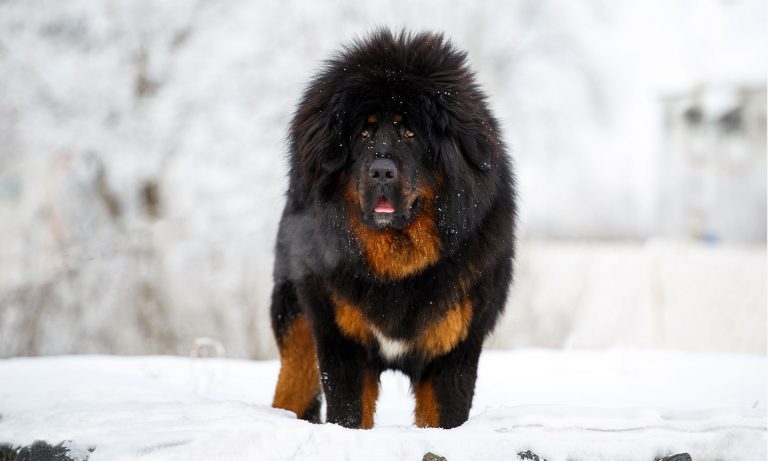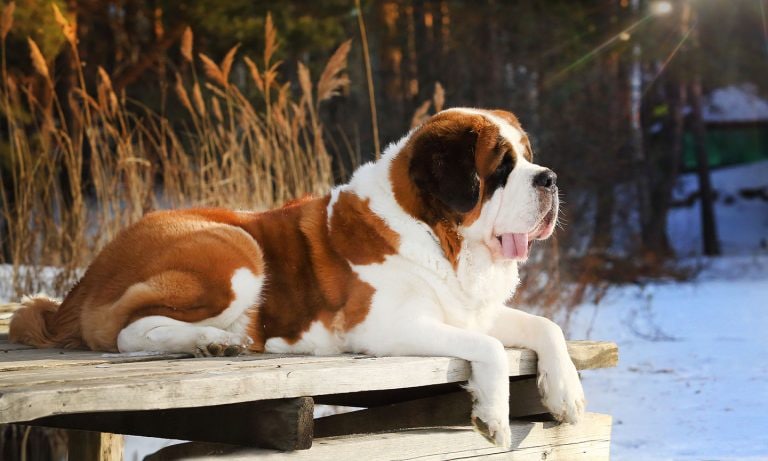Tibetan Mastiff vs Saint Bernard

Breed Snapshot
Best For
The majestic and independent Tibetan Mastiff makes a devoted family pet. Ranking among the largest dog breeds, they thrive with a job to do and plenty of room to roam.
Tibetan Mastiff Temperament
Tibetan Mastiffs are independent introverts who tend to be wary of strangers but are loving and loyal to their people. Though personality can vary from one dog to the next, these dogs tend to be headstrong and often think they know what’s best and view themselves more as equ...
Tibetan Mastiffs are independent introverts who tend to be wary of strangers but are loving and loyal to their people. Though personality can vary from one dog to the next, these dogs tend to be headstrong and often think they know what’s best and view themselves more as equal partners than pets.
Like all dogs, Tibetan Mastiffs require proper socialization from the time they’re a puppy. But with plenty of exposure to different people, pets and situations throughout their lives, they’ll be more accepting, though perhaps still aloof, reserving their affection for loved ones.
Pet parents need to be diligent about working with their pup to prevent biting tendencies. They have a bite force of 500 pounds, stronger than that of an American Pit Bull Terrier or German Shepherd, so even a playful bite could do major damage.
Tibetan Mastiff puppies can be taught to get along well with children and other pets when raised with them, but as adults, they may be less accepting of new dogs or other people’s children. And with their sheer size and strength it’s a good idea to supervise even well-socialized Tibetans around young children, cats or small dogs. Remember to teach all children how to interact gently and respectfully with dogs.
Their bossy natures make them a bad fit for obedience competitions, and they’re not built for agility or speed. But give these dogs some sheep, goats or cattle to guard, and watch them excel. They were bred to guard livestock, after all, and they’re at their best and happiest when they’re allowed to be watchful over their domain.
Tibetan Mastiff Traits

Breed Snapshot
Best For
Drooly gentle giants, Saint Bernards are best for larger homes with experienced pet parents who can provide lots of focused training and regular exercise—and keep up with their grooming needs. Known for their calm...
Drooly gentle giants, Saint Bernards are best for larger homes with experienced pet parents who can provide lots of focused training and regular exercise—and keep up with their grooming needs. Known for their calm and affectionate nature, these teddy bears are kid- and pet-friendly, to boot.
Saint Bernard Temperament
Would you ever expect your personal bodyguard to be mistaken for a floofy teddy bear? Probably not, but you should. (Because: safety first. And also because: adorable.) Saint Bernards’ gentle, calm demeanor with a dash of playfulness are a natural fit for homes with older children, other dogs and eve...
Would you ever expect your personal bodyguard to be mistaken for a floofy teddy bear? Probably not, but you should. (Because: safety first. And also because: adorable.) Saint Bernards’ gentle, calm demeanor with a dash of playfulness are a natural fit for homes with older children, other dogs and even friendly felines. They’ll also mesh with younger children, but littler kiddos will need extra supervision to ensure they can respect your pup’s boundaries.
A Saint Bernard dog doesn’t always comprehend just how big they are, which can cause some consternation and tears when playing with tipsy tots or unstable adults (or tipsy adults, for that matter). Training for both humans and the dog is a must to be sure nobody accidentally gets knocked over during backyard romps or in-home zoomies. Saints are friendly dogs (and they swear they didn’t mean to knock you down! They thought you were trying to start a game of tag!) and will stay that way with a loving home and positive reinforcement-based training. In general, Saints are not known to bite, but it’s always important to properly socialize and train any dog. Socializing your Saint Bernard puppy before 20-24 weeks of age allows your outgoing pup to learn good manners and blossom as a beloved family pet.
If it looks like you’re going to do something fun, Saints will want to join you, no questions asked. They’re in the car before you can even find your keys, ready for a nature trail adventure or a Sunday drive through the country. Whatever their human is doing, they want to mirror the activity or supervise from a cozy spot next to your feet.
If you have a job you need doing, give it to a Saint, and they will be more than happy to check it off your to-do list. Saint Bernards are a working breed who love to help people. Give them a chore, like helping feed livestock on a farm or serving as a door greeter at your small business, and they’ll be happy campers. Saints are eager to please. You’ll know the Saint Bernard is in their element when they can’t stop the drool from flowing and their tail from wagging.




